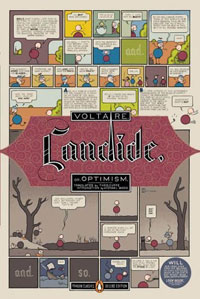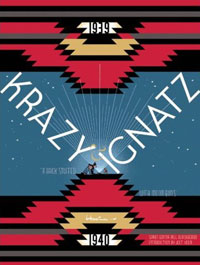
Did you see those great Penguin Modern Classics Deluxe Editions imports from the USA? I just found a few in the local Waterstones yesterday. We don’t normally get the US books in there, but there’s obviously someone new who knows their stuff. They had a load of those fabulous Library Of America hardback collections of ’40s and ’50s Noir in there a couple of months ago, and at such keen prices. It’s enough to make me wish I had never read those stories already.
But the new Penguin Modern Classics Deluxe Edtions. What a treat those are. I felt like a kid on a candy store. I just had to have them, and forget the fact that I already own almost all the titles in other imprints. But I’m such a sucker for great covers. And as a comics lover, well how could I fail to be seduced by the likes of Frank Millar, Seth, Chris Ware, Jason, Chester Brown and Yoshihiro Tatsumi? Each of them has produced an original piece of artwork for the books. Each of them is worth the admittance price alone. The fact that you get some awesome literature into the bargain is only a bonus. And I know some will argue I got that the wrong way around, but they would be mistaken.
Now I am old enough to remember when the Penguin Modern Classics books came with paintings on the covers. I remember when they then began to use classic modernist photographs with that lovely pale turquoise spine. Those looked beautiful on a shelf. We still arrange ours all together. Now they have started to use comics’ illustrators. Is this a sign of comics’ artists being accepted in the pantheon of Art? Is it a shrewd marketing ploy by a PR guru who has the target audience nailed? Who cares. Just enjoy the damn books and marvel at the glorious covers.

If I had to choose one of those as being a favourite, it would be a coin toss between Seth’s Portable Dorothy Parker and Chris Ware’s Candide. Ware probably just edges it. I’m such a sucker for his ludicrously shaped stick and ball figures. They crack me up every time. He’s such a demon colourist as well. And a genius of frame sequencing. The fact that he is also a writer of rare eloquence and sensitivity only helps to mark him out as the comics-laureate of our times.
Actually I remember the first time I heard of Ware being referred to in those terms. It was early in 2001, Mike Morris writing right here. I was still easing into comics at that time, and Morris totally sold me. I couldn’t find anything in my local stores, but an Easter holiday in San Francisco meant I was able to find a couple of his early ACME collections. It was a revelation. I read the Jimmy Corrigan episode in ACME 7 and wept. This was visual poetry, was comics like I could never have imagined and yet somehow knew I had always wanted. It helped that Ware was clearly a design genius as well.
After that I picked up as much Ware as I could. I particularly loved those outsize format Big Book Of Jokes titles. A bugger to store, but truly magnificent artefacts. Of course it was in the second issue of those that we were first introduced to Rusty Brown. The extended strips in the most recent volumes of the ACME series (16 and 17, now published by Drawn And Quarterly) meanwhile take us back to Rusty’s childhood to fill in the back-story. And what a back-story it is, with the bumbling and seedy Mr Brown senior, the obnoxious longhaired Freak bullies, the new-to-towners Alice and Chalky White and the strange cameo of Mr Ware the Art teacher who smokes pot in the back of cars with his students. Of course not all Art teachers are the same.
Now didn’t Douglas Coupland write something about how all families are psychotic? Well I’d wager that Ware and Coupland share a certain world view on that one, because the relationships in Rusty Brown are, like those in Jimmy Corrigan, stressed out to breaking points, cracked and fissured beyond repair. Even the youthful bonds of the put-upon outsiders are flawed: “How come you’re really only nice to me when we’re not at school?” says Chalky to Rusty in the 1973 souvenir pull-out calendar in that second volume of the Big Book Of Jokes. Which pretty much says it all.

I understand there are those who think that Rusty Brown is not as good a character as the seminal Jimmy Corrigan, but personally I like the Rusty stories more. Maybe it’s the fact that they are rooted in a mythic hinterland of ‘70s and ‘80s Americana; like Freaks and Geeks with superhero obsessions. Whatever. I’m awaiting the next volume of ACME with the same sense of eager anticipation I did six years ago. It’s good to feel those sorts of constants in life.
Another of Ware’s classic characters is Quimby Mouse, which I always saw as homage to the classic George Herriman Krazy Kat comic of the ‘30s and ‘40s. No surprise then that Ware designs and decorates Fantagraphics new 1939-1940 Krazy and Ignatz collection. I first came across Krazy Kat in the psych/garage fanzine Strange Things Are Happening in the ’80s. Because of that I had it down as a freakbeat underground comic from the ’60s, somehow connected to the likes of Robert Crumb. How naïve I was. But really, that psych connection is right in there, and in fact when you explore some of those old American comics from the ’20s through to the ’40s, there is a lot of latent psychedelia, years ahead of its time. It’s the same with music. When you listen to the old folk recordings that Harry Smith collected, they sound so much stranger than all of those forced psychedelic sounds that came 40, 50 years later. And of course Smith was right in there with Ginsberg and The Beats and so the connections follow through. Well Herriman’s Krazy Kat is right in there in the mix too. Operating within a simple structure of characters and motivations, Herriman was able to go to town with a surreal imagination. Less is more, indeed. It all fits.
© 2007 Alistair Fitchett